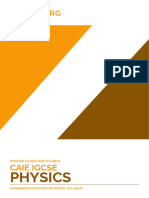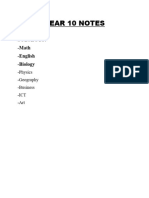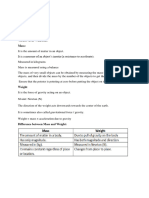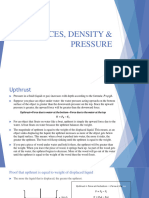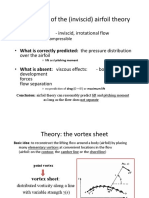0 ratings0% found this document useful (0 votes)
11 viewsUpdated Physics Notes
Uploaded by
LindaCopyright
© © All Rights Reserved
Available Formats
Download as PDF, TXT or read online on Scribd
0 ratings0% found this document useful (0 votes)
11 viewsUpdated Physics Notes
Uploaded by
LindaCopyright
© © All Rights Reserved
Available Formats
Download as PDF, TXT or read online on Scribd
You are on page 1/ 4
Acceleration:
● Acceleration is defined as the change in velocity
per unit of time.
● a=v-u/Δt= Δv/Δt Where:
● a is acceleration
● v is final velocity
● u is initial velocity
● Δt is change in time
1.5 forces
● A force is a push or a pull. Forces may produce changes
in the size, shape, and velocity of an object.
● Solid friction is the force between two surfaces that may
impede motion and produce heating.
● Friction (drag) acts on an object moving through a liquid
or a gas (air resistance).
Center of mass:
● The center of mass is the place at which all of the
object's mass is concentrated. Because gravity works
only on one spot in the item. For regularly formed
objects, the center of mass is in the center. It is critical
to understand where a body's center of mass is located,
as this dictates the body's stability. When a body is tilted
slightly, the line of action of its weight passes through
its base, it is stable.
Resultant force:
● Determine the resultant of two or more forces acting
along the same straight line. An object either remains at
rest (stationary) or continues in a straight line at
constant speed unless acted on by a resultant force. A
resultant force may change the velocity of an object by
changing its direction of motion or its speed.
Centripetal force:
● Describe the motion in a circular path due to a force
perpendicular to the motion.
● In a circular motion, if speed increases, the force
needed increases (mass and radius are constants). In a
circular motion, if the radius decreases, the force
needed increases (mass and speed are constants).
● In a circular motion, if mass is increased, an increased
force is required to keep speed and radius constant.
Moment of force:
● Moment of a force as a measure of its turning effect.
● The moment of a force is defined as moment = force x
perpendicular distance from the pivot.
● Apply the principle of moments to situations with one
force on each side of the pivot, including the balancing
of a beam. When there is no resultant force and no
resultant moment, an object is in equilibrium.
● Apply the principle of moments in situations with more
than one force on each side of the pivot.
● Describe an experiment to demonstrate that there is no
resultant moment on an object in equilibrium. The
stability of an object depends on the position of its
center of gravity
Mass and Weight
● Mass: is a measure of the quantity of matter in an object at
rest relative to the observer. The mass of a body is a
measure of the amount of matter in it.
● Weight: a gravitational force on an object that has mass.
● Gravitational field strength g is defined as force per unit
mass
● The equation for gravitational field strength is :
● g= w/m
● Gravitational field strength is equivalent to the acceleration
of free fall.
● Weights (and masses) may be compared using a balance.
● The weight of an object is the effect of a gravitational field
on its mass.
Stretching and compressing:
Stretching and compression are two types of forces that can change
the shape of an object. When something is stretched, it becomes
longer. When something is compressed, it becomes shorter. These
forces are important in understanding how materials behave,
especially in engineering and construction. For example, when a
rubber band is stretched, it stores energy that can be released when
the band is let go.
force may produce a change in size and shape of a body. This is
called deformation:
● Elastic deformation:
The object returns to its original shape when the load has been
removed, an example being a spring being stretched under
normal usage.
● Plastic deformation:
The object does not return to its original shape when the load
has been removed, an example being a spring that has been
stretched too far.
Momentum:
Momentum is defined as mass x velocity (kg m/s)
The equation for momentum is
p=mv Where:
p is momentum
m is mass
v is velocity
Resultant force is defined as the change in momentum per unit time:
F= Δp/Δt
∴F= mΔv/Δt
Impulse of a force is defined as force x time for which force acts:
Impulse=FΔt=Δ(mv)
The principle of the conservation of momentum:
General law of physics according to which the quantity called
momentum that characterises motion never changes in an isolated
collection of objects; that is, the total momentum of a closed system
remains constant.
Pressure:
Pressure is defined as force per unit area and measured in N/m or Pa.
1 Pa = 1 N/m^2
The equation for pressure is:
p= f/a
Where:
p is pressure
F is force
a is area
Pressure beneath the surface of a liquid changes with the depth and
density of the liquid. The equation gives the change in pressure
beneath the surface of a liquid:
change in pressure = density x gravitational field strength x change in
depth
Δp=ρgΔh Where:
Δp= pressure difference in pascals (Pa)
ρ = density in kilograms per cubic metre (kg/m3)
g = gravitational field strength (N/kg)
Δh = change in height/height of vertical column (m)
You might also like
- Unit 2. Motion and Forces 2023 To 2024 VersionNo ratings yetUnit 2. Motion and Forces 2023 To 2024 Version37 pages
- Grade 7physics Notes Ch-11Pushes & pulls2024-25No ratings yetGrade 7physics Notes Ch-11Pushes & pulls2024-253 pages
- Chapter 2: Forces and Motiondistance Displacement Speed Velocity Mass Acceleration Inertia Momentum Force Impulsive Force Gravity Free FallNo ratings yetChapter 2: Forces and Motiondistance Displacement Speed Velocity Mass Acceleration Inertia Momentum Force Impulsive Force Gravity Free Fall13 pages
- 1.1---Fundamentals-of-Forces-Workbook copyNo ratings yet1.1---Fundamentals-of-Forces-Workbook copy48 pages
- KSSM (Content Standard / Learning Standard) Check List Igcse (Subject Content) Check ListNo ratings yetKSSM (Content Standard / Learning Standard) Check List Igcse (Subject Content) Check List64 pages
- Understanding The Structure and Function of The HeartNo ratings yetUnderstanding The Structure and Function of The Heart2 pages
- Work, Power, Energy - 2 (Xii 2022-24) (Ans) 22 06 23No ratings yetWork, Power, Energy - 2 (Xii 2022-24) (Ans) 22 06 232 pages
- Good Morning Class: I Am Teacher Kristine Monderin (Physics Teacher)No ratings yetGood Morning Class: I Am Teacher Kristine Monderin (Physics Teacher)28 pages
- Vibration Chapter 2.6 Damped Free VibrationsNo ratings yetVibration Chapter 2.6 Damped Free Vibrations36 pages
- Incompressible Flow in A Duct: The Venturi and Low-Speed Wind Tunnel Sec 3.3No ratings yetIncompressible Flow in A Duct: The Venturi and Low-Speed Wind Tunnel Sec 3.314 pages
- Describing Motion: Third Quarter PhysicsNo ratings yetDescribing Motion: Third Quarter Physics26 pages
- Elasticity of Fluid and Pipe Wall: Fig. 3.2-b: Pressure and VelocityNo ratings yetElasticity of Fluid and Pipe Wall: Fig. 3.2-b: Pressure and Velocity1 page
- ScienceFlip - The Nature of Light Booklet No SpacingNo ratings yetScienceFlip - The Nature of Light Booklet No Spacing15 pages
- A-Level Physics: Y12 Capability AssessmentNo ratings yetA-Level Physics: Y12 Capability Assessment17 pages
- Physics: Laminated QuickStudy Reference GuideFrom EverandPhysics: Laminated QuickStudy Reference Guide
- Chapter 2: Forces and Motiondistance Displacement Speed Velocity Mass Acceleration Inertia Momentum Force Impulsive Force Gravity Free FallChapter 2: Forces and Motiondistance Displacement Speed Velocity Mass Acceleration Inertia Momentum Force Impulsive Force Gravity Free Fall
- KSSM (Content Standard / Learning Standard) Check List Igcse (Subject Content) Check ListKSSM (Content Standard / Learning Standard) Check List Igcse (Subject Content) Check List
- Understanding The Structure and Function of The HeartUnderstanding The Structure and Function of The Heart
- Work, Power, Energy - 2 (Xii 2022-24) (Ans) 22 06 23Work, Power, Energy - 2 (Xii 2022-24) (Ans) 22 06 23
- Good Morning Class: I Am Teacher Kristine Monderin (Physics Teacher)Good Morning Class: I Am Teacher Kristine Monderin (Physics Teacher)
- Incompressible Flow in A Duct: The Venturi and Low-Speed Wind Tunnel Sec 3.3Incompressible Flow in A Duct: The Venturi and Low-Speed Wind Tunnel Sec 3.3
- Elasticity of Fluid and Pipe Wall: Fig. 3.2-b: Pressure and VelocityElasticity of Fluid and Pipe Wall: Fig. 3.2-b: Pressure and Velocity
- ScienceFlip - The Nature of Light Booklet No SpacingScienceFlip - The Nature of Light Booklet No Spacing
